There are many types of spiders that call Florida home. As such, they are a common sight in gardens, wooded areas, and even around the house. Although black spiders may look intimidating, and some can be venomous, it does not mean all black spiders you come across in Florida are dangerous. In fact, some can even be helpful in getting rid of mosquitos and other pesky insects. With that being said, it is always important to be cautious around any spider. This is especially true if you are unsure of the species. So take a look at these six common spiders to get better acquainted:
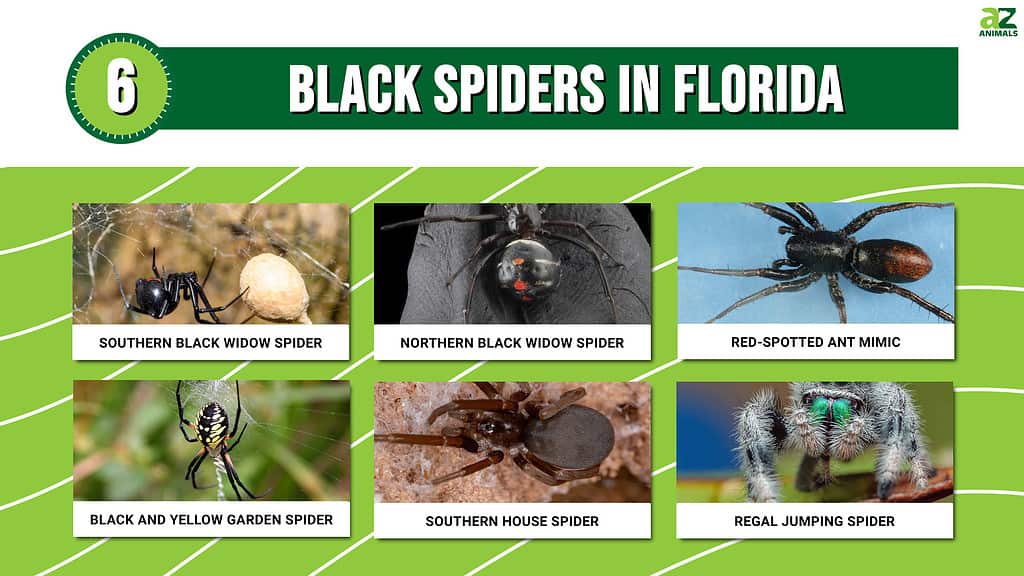
Now read on to learn more information about the six common species of black spiders in Florida!
Southern Black Widow Spider

Indigenous to the southeastern United States is the southern
black widow spider
, an extremely venomous spider. Their venom is 15 times more powerful than a rattlesnake’s.
©Jeff W. Jarrett/Shutterstock.com
The southern black widow spider, Latrodectus mactans, is an extremely venomous spider that is found and is indigenous to the southeastern United States. The females are shiny and black with a distinctive red marking of a complete hourglass on the ventral side of the abdomen. Many also have an orange or red patch on top of the abdomen as well. The abdomen is large and round, and the legs of the spider are long in proportion to its body.
The southern black widow spider typically preys on insects but also preys on woodlice and other arachnids. The spider catches its prey with its web – the web is so strong that even mice can get caught in it! Once the prey is caught in the web, the spider will come out, wrap it, and then bite and envenom its prey.
Luckily for the southern black widow spider, it is common and not endangered. However, if you do encounter one of these striking spiders, make sure to keep your distance as their bite is venomous. Although the southern black widow spider rarely bites humans, their venom contains a very potent neurotoxin that can cause pain and, in some cases, death. Their venom is 15 times more powerful than a rattlesnake! So, if you see one of these black spiders, be aware!
Northern Black Widow Spider
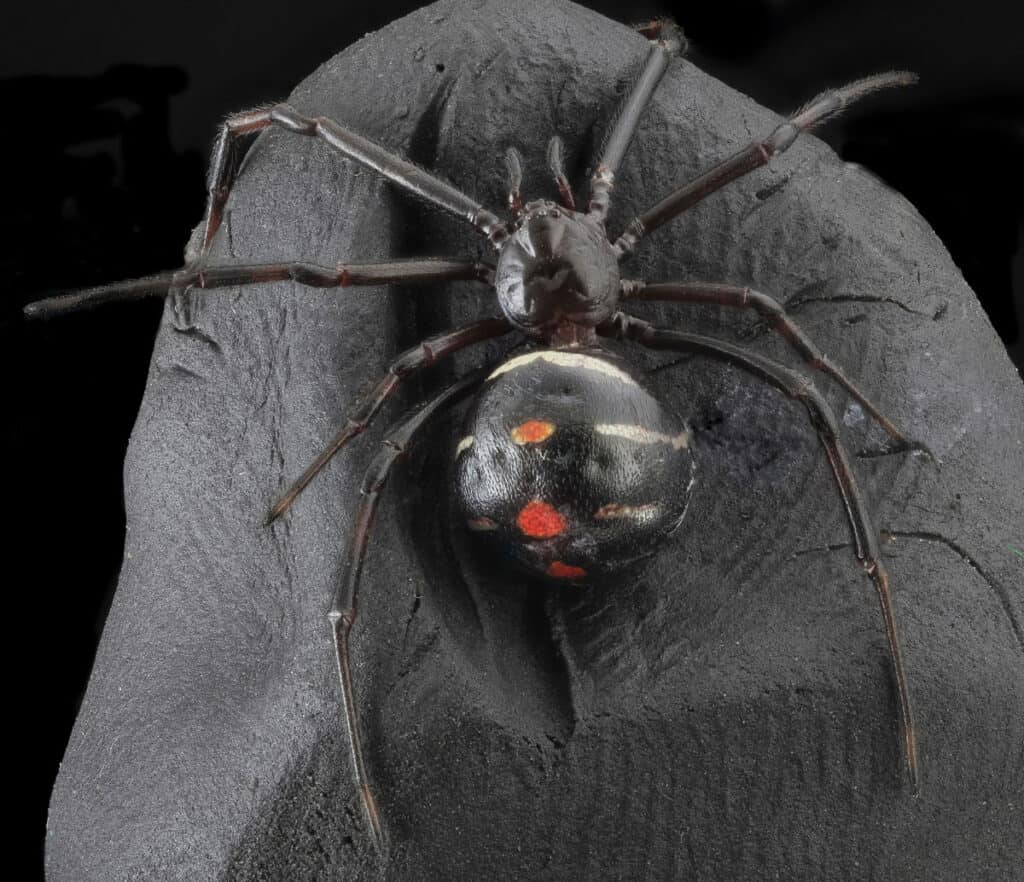
Equally dangerous to southern black widows are northern black widows.
©Porco_Rosso/Shutterstock.com
The northern black widow, Latrodectus variolus, is very similar to its southern cousin but is found in the North Eastern region of Florida and is less common. The northern black widow spider has a shinier appearance than the more matte-looking southern widow. It is also slightly larger than the southern widow and features a red “broken” hourglass image on its abdomen. Both the northern and southern widow spiders have extremely venomous bites, and they are considered two of the most venomous spiders in North America. Their venom can cause serious health effects; however, bites are rare, and fatalities are even rarer due to the wide availability of antivenom. Nevertheless, it is still very important to be cautious around these spiders!
The northern black widow spider has the same prey as the southern one. Bugs, insects, and woodlice make up this spider’s diet. As with the southern widow, a web is used to catch prey.
Something interesting about the black widow spider is that the young are cannibals! If they hatch together at varying sizes and get the chance, the larger of them may eat their smaller brothers and sisters. The theme of cannibalism is actually what brought the term “widow” about in their name. In captivity, the female would eat their male mate after breeding. This is a bit of a misconception as in the wild, the male would have somewhere to flee. It is now estimated that only 2% of males meet the grim fate of being eaten by their female friends.
Red-Spotted Ant Mimic
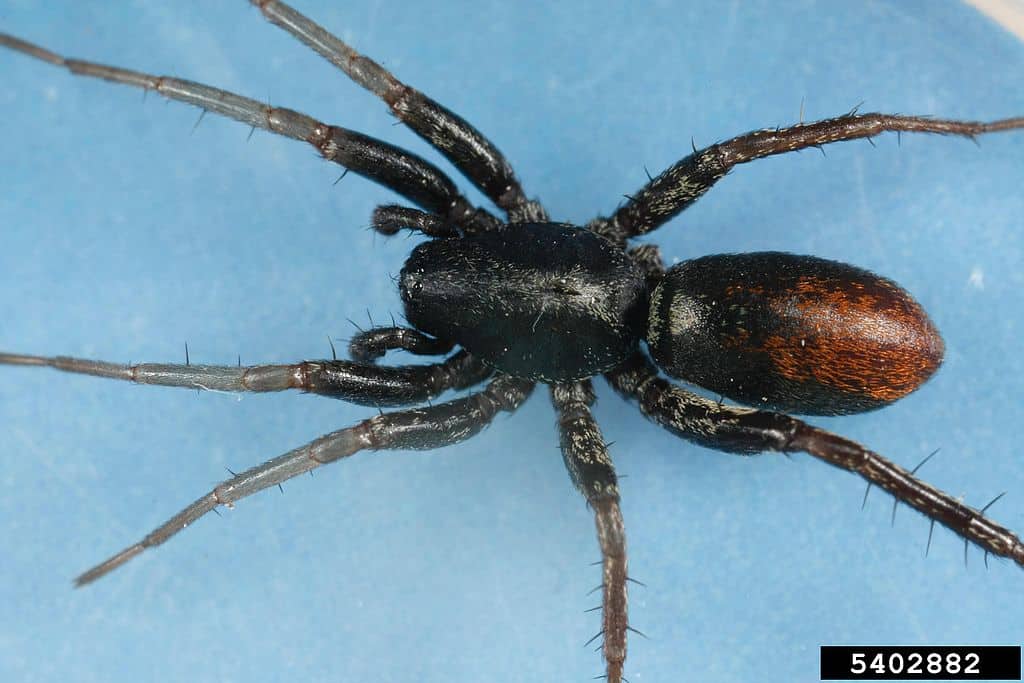
They’re not venomous, but the bite of a red-spotted ant mimic can cause irritation and swelling.
©Joseph Berger, Bugwood.org; University of Georgia / CC BY 3.0, via Wikimedia Commons – License
The red-spotted ant mimic spider, Castianeira descripta, is found throughout the United States and Canada and gets its name from their behavior, which is similar to ants. This spider can be confused with some species of the black widow as it is also black, hairless, with a red marking on the back. If you are unsure which species of spider you are dealing with, it is best to not handle the spider.
The red-spotted ant mimic spider is a hunter spider, meaning it does not build a web to catch its prey. The targets for this spider usually include small insects or ants. The spider is proactive in catching its prey as it wanders around searching for its next meal. It often walks with its two front legs in the air giving the appearance of an ant with antennae. One theory is that these spiders mimic the movements and behavior of ants to get close enough to catch one.
These spiders are common and not an endangered species. Although not venomous, the spider has a strong bite that can cause irritation and swelling — almost like a bee sting. If you are allergic to this strange spider, it will be best to stay away as they are quite an aggressive species and may bite if you get too close.
Black and Yellow Garden Spider

The venom of black and yellow garden spiders is harmless to humans, so long as you’re not allergic to the venom.
©iStock.com/AwakenedEye
The black and yellow garden spider, Argiope aurantia, is most commonly found in the United States, Hawaii, southern Canada, Mexico, and Central America. However, they are also commonly found in Florida. The spider is known by many names, including the yellow garden spider, zigzag spider, the golden sild spider, and black and yellow argiope. As its name suggests, this spider has distinctive black and yellow markings on the abdomen with a mostly white head.
The black and yellow spider builds webs and preys on small vertebrates and insects. The web of the spider has a distinctive zigzag shape which is why it gets the nickname “zigzag spider”. Once the prey is secure, the spider injects its venom into the prey to kill it and then wraps it up with its silk to feast later.
The spider is quite common and can be found in gardens, therefore it is not endangered. Although the black and yellow spider does have venom, it is harmless to humans who are not allergic to them. These spiders will only bite if they are disturbed or harassed, and the bite has around the intensity of a bumblebee sting.
Southern House Spider
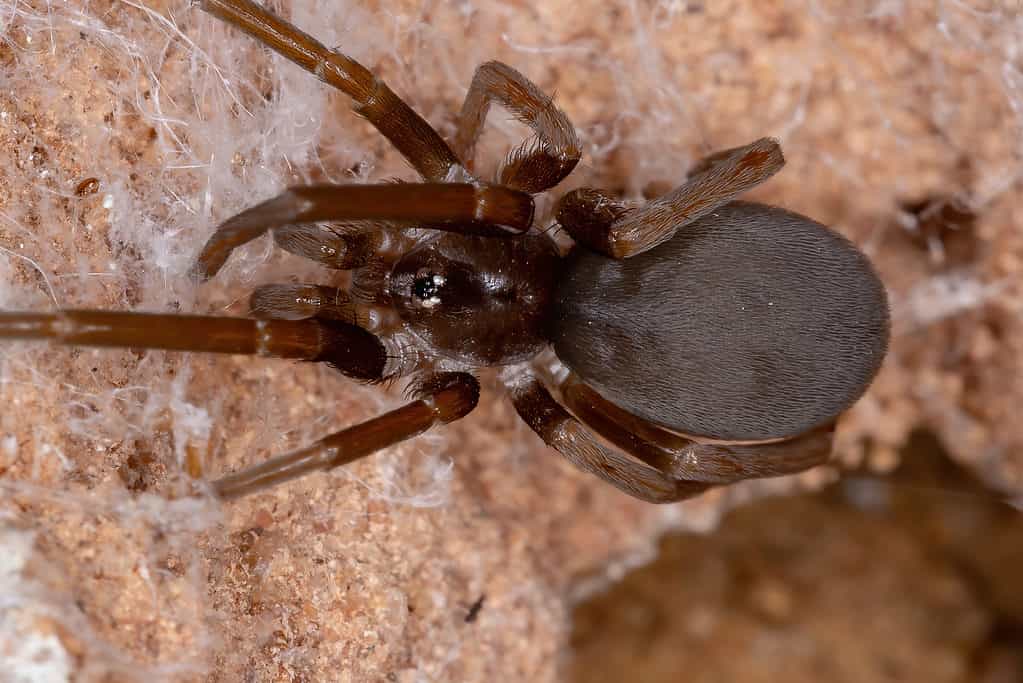
Female southern house spiders are black or charcoal gray, much different from their amber-colored male counterparts.
©Vinicius R. Souza/Shutterstock.com
The southern house spider, Kukulcania hibernalis, is found in the southern United States, including Florida. They primarily inhabit areas that are populated with humans, hence their name southern “house” spider. This species of spider is unique as it exhibits strong sexual dimorphism. The males are brown and are easily mistaken for brown recluse spiders. The females are black or dark brown and have larger bodies than the males. The abdomen of this spider is covered with light gray hair.
The male southern house spider searches for prey and females, while the female southern house spider uses a web instead. The diet of the southern house spider includes small insects such as horseflies, houseflies, and cockroaches. The webs spun by these spiders are flat and tangled and have a wooly texture.
The southern house spider is commonly found and is not endangered — and if you can tolerate them, they are a perfect housemate for getting rid of those pesky flies! Luckily for us, these spiders are not venomous. However, the males can be described as aggressive as they tend to walk over anything due to their blindness. Their bite is not dangerous to humans, so don’t be afraid to have these little guys hanging around!
Regal Jumping Spider
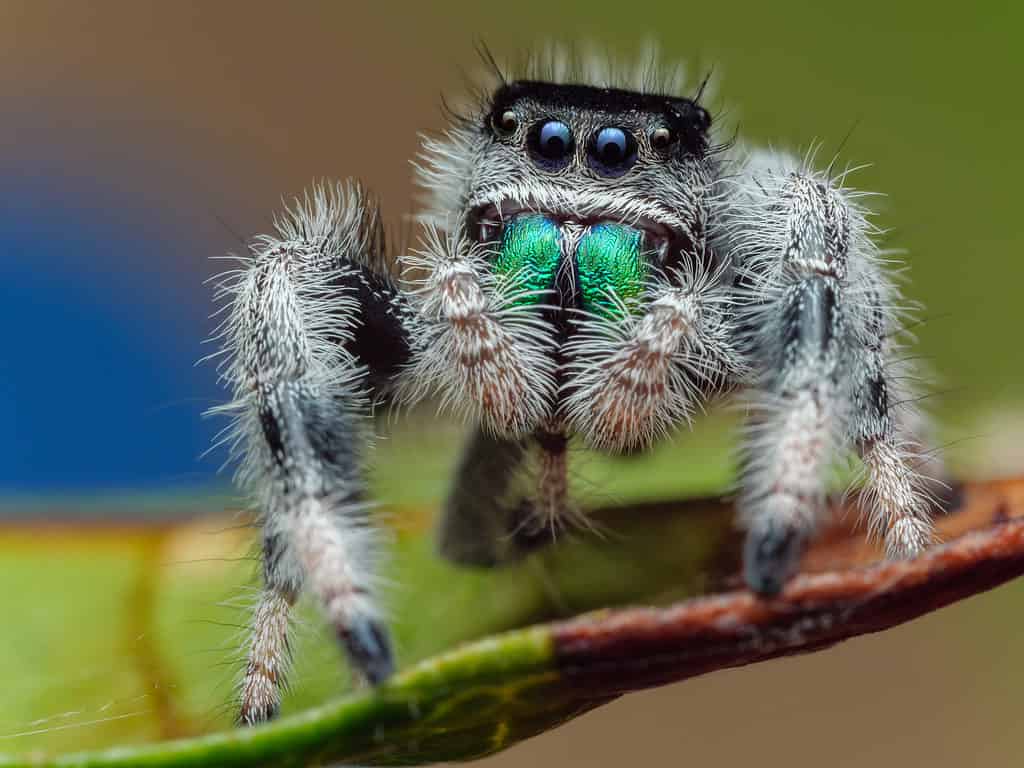
Regal jumping spider male sub adult –
Phidippus regiusspecies from USA Florida Everglades.
©iStock.com/Macrolife.it
The regal jumping spider, Phidippus regius, is found in the southeastern United States. So, it is common to find across Florida. This spider is also sexually dysmorphic, making it easy to distinguish between the males and females of the species. The females tend to have distinct coloration that consists of orange and gray patterns. The males, on the other hand, are black with white spots and stripes. The males are smaller at 0.24 to 0.71 inches in length, while females are generally between 0.28 and 0.87 inches in length.
The webs that the regal jumping spider makes are not used for capturing prey, and rather they are for sleeping and caring for the spiderlings. These spiders are hunters and feed on a variety of insects, including crickets, flies, and moths, and capture their prey by pouncing on them.
The regal jumping spider is not endangered and is commonly found in Florida. Although the spider does have fangs and produces venom, the venom is not harmful and not dangerous. In fact, this species of spider is a very popular pet!
Summary of the 6 Black Spiders in Florida:
| Common Name | Scientific Name | Danger to Humans |
|---|---|---|
| Southern Black Widow Spider | Latrodectus mactans | Potentially deadly venom, but anti-venom available |
| Northern Black Widow Spider | Latrodectus variolus | Potentially deadly venom, but anti-venom available |
| Red-spotted Ant Mimic Spider | Castianeira descripta | Non-venomous, but bite can cause irritation and swelling |
| Black and Yellow Garden Spider | Argiope aurantia | Venomous, but harmless to humans unless allergic |
| Southern House Spider | Kukulcania hibernalis | Non-venomous; harmless bite |
| Regal Jumping Spider | Phidippus regius | Fangs and venom, but not harmful to humans |
The photo featured at the top of this post is © Porco_Rosso/Shutterstock.com
Thank you for reading! Have some feedback for us? Contact the AZ Animals editorial team.







